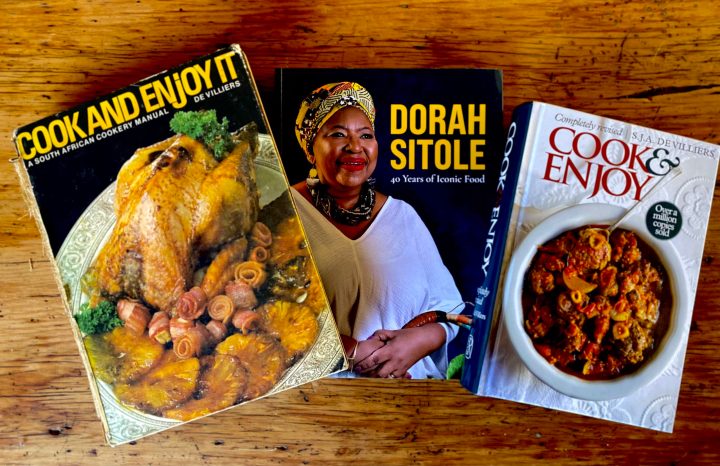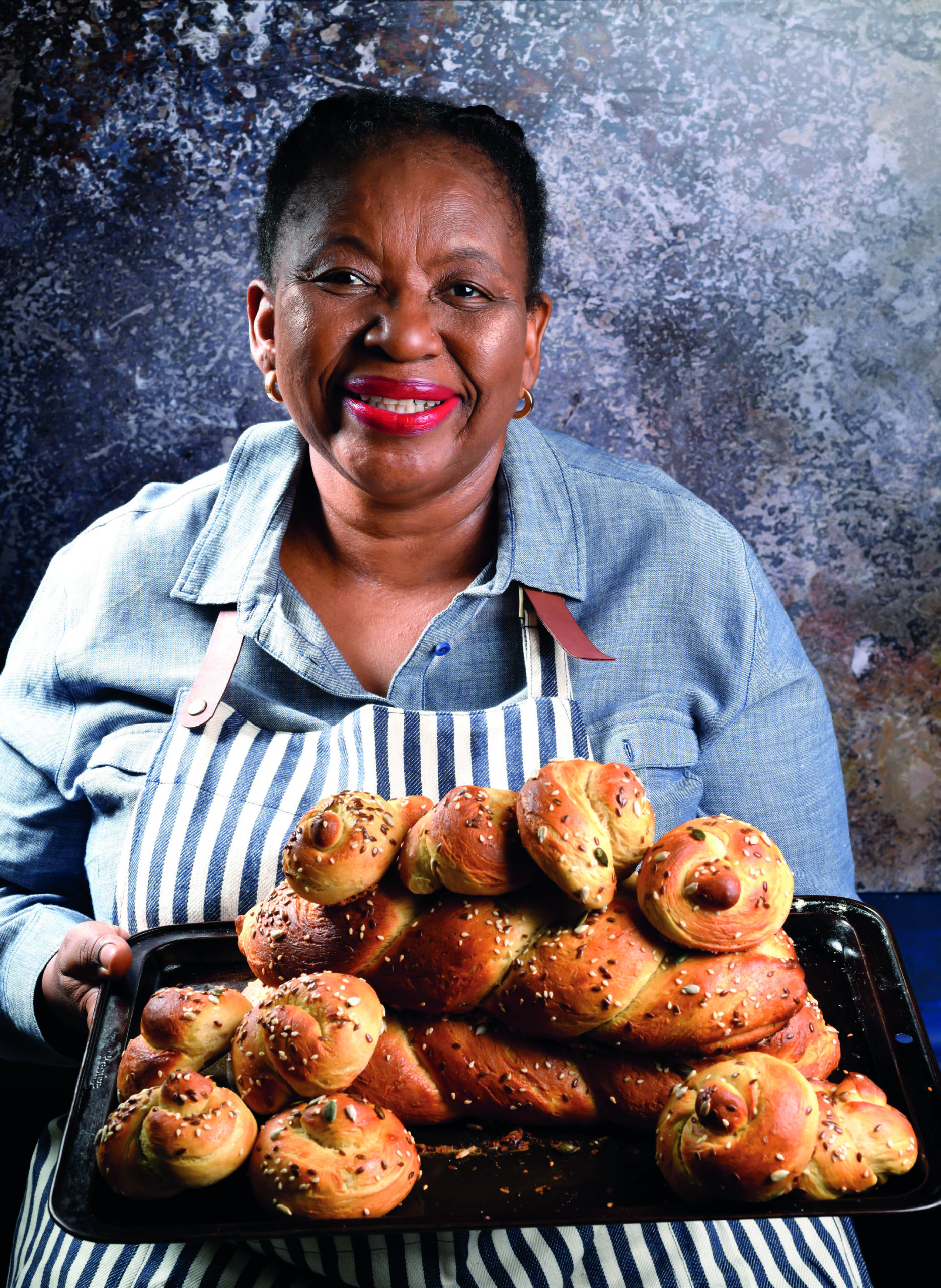FULL CIRCLE
From SJA de Villiers to Dorah Sitole

Next to your tatty old copy of Cook and Enjoy It in your cookbook collection, make space for a new tome that deserves to become a new South African classic: Dorah Sitole: 40 Years of Iconic Food (Human & Rousseau).
Once in a while a cookery book comes along that stands out from the pack. Dorah Sitole’s new book is a tour de force that closes the circle opened by SJA de Villiers when she first published Kook en Geniet in 1951. It deserves to be on any South African kitchen bookshelf worth its salt.
Seven decades after SJA de Villiers, a Stellenbosch home economics graduate, self-published an encyclopaedic Afrikaans cookery book with her geologist husband Japie, in 1951, Dorah Sitole writes in her foreword for her newly published book, Dorah Sitole: 40 Years of Iconic Food: “I would love this cookbook to be a well-thumbed reference book that will sit on kitchen worktops and be used as a guide to all things culinary! I see it doing what my very first recipe book, Cook and Enjoy It, a South African Cookery Manual by SJA de Villiers (which my late husband Archie gifted to me in the first year of our marriage), did for me.”
This would be sweet and lovely but not notable were the book not the triumph that it is.

Grilled mielies with two sauces, by Dorah Sitole. (Photo: Roelene Prinsloo)
Like the De Villiers classic, it deals chiefly with well known recipes we all would like to know how to make, but then she throws in a slew of modern dishes as well. And, though she starts with and steers a course through so many South African dishes – and it is important in this context that her recipes run the gamut of our entire nation’s cuisines – she then forays abroad to show off the culinary wonders she encountered in her many travels in Africa and throughout the world.
Sitole had chanced into food writing when she took a job as a home economist for the Canned Food Advisory Service and, in 1987, fell into writing about food for True Love magazine.

Dorah Sitole with the results of her rich bread dough. (Photo: Roelene Prinsloo)
She tells her life and food story, richly and sweetly, and walks us through the food of her decades. Not “only” the four decades in the food and food writing industries, but the “two decades that prepared me for the path I was to walk” and on to what she calls “my encore years”.
Sitole writes of the De Villiers classic Cook and Enjoy It: “The first edition of that modest book had zero food pictures in it, but was packed with basic recipes, and a few advanced ones, turning me into a confident cook.” So how does her book compare?
First, it does not attempt to be exhaustive in the way that the De Villiers book was (and it is still in print, remarkably). That was a niche that was filled in 1951 and remains filled, and Sitole and her publishers evidently knew the wisdom of this. This is not a manual, nor does it attempt to be. While being a walk through the author’s life and food journey, it also traipses through the kinds of recipes we all look to Cook And Enjoy It for when we want a traditional recipe we can trust, but woven into this are the foods of Sitole’s life that escaped De Villiers’ notice, because our world was different then.
Right from the off, Sitole steals a march on De Villiers (hindsight being a wonderful thing) with recipes for most of the recipes white South Africans have heard of but either never tasted or made for supper. The first recipe in the book is Grilled Mielies, the second Morogo with peanut butter, the fourth Umleqwa (hard-body or hand-raised chicken), the sixth Isijingi (pumpkin porridge) and, on page 23, there’s all you need to know about cooking Grilled Maotwana (chicken feet), for which you’ll need cooking oil, chicken spice, Louisiana Cajun spice, peri-peri, then two hours’ marination and grilling over hot coals. I confess to never having tried it, but will soon.
This is followed by “sizzling gizzards”, skewered, Bohobe bating le tshotlo (sour porridge with pounded meat), tripe curry, Idombolo (steamed bread), Amanqina (trotters stew), Amagwinya (vetkoek), and, delightfully, Umqombothi, so you will now have a recipe for African beer should Oom Cyril and his lieutenants decide to shut the liquor stores again. In case you ever wondered, you’ll need: 1 kg King Korn Mtombo Malt, 500 g maize meal, 12 litres of water and a quarter cup of brown sugar. Then follow eight steps followed by a tip: “On the second day, add two litres of store-bought sorghum beer to assist with the fermentation.”
Her childhood years in Soweto deliver such dishes as beef bone and vegetable soup, lamb and bean stew, and samp and beans, and the last is the only of the above recipes that I have ever made, back in my mid-teens when my mom and I lived on social welfare food parcels for much of a year and my young eyes stared, puzzled, at packets of dried beans and samp and wondered what to do with them. And look, as they say, at me now. I’m grateful, to say the very least, and respectful of my good fortune, as Dorah Sitole is of hers, after an early life many times more deprived than my piffling hardships.

Chicken feet stew. (Photo: Roelene Prinsloo)
I can’t help thinking: If SJA de Villiers had known these recipes back in 1951, and had included them in her book, would we all have grown up with them, and would it have helped bridge the chasm? We will never know, but to add this book to your collection, and position it on the shelf right next to Cook And Enjoy It, would seem so right.
Which brings us to the better times. Over the years Sitole kept a notebook of recipes and bits and bobs of culinary information she wanted to remember. So, in her From My Notebook chapter, she brings us the recipes that formed her early skill set: minestrone; a good old Seventies moulded salmon mousse set in a copper fish mould; pizza, fish cakes and Nasi Goreng, a dinner party staple long out of fashion but overdue for a revival. Then, chicken, broccoli and mushroom pie, beef Stroganoff, mutton curry bunny chow (yes please), a Sunday beef roast, butterflied leg of lamb with garlic herb dressing, and on to sweet treats like banana bread, orange tea loaf, spiced pear butter cake, ginger biscuits and a lime and cream cheese fridge tart, Tennis biscuit base and all; pure Kook en Geniet, in other words.
Then, in Becoming a Culinary Goddess (step aside, Nigella), she starts jazzing it up with Roquefort pear salad, veal paprika, rack of lamb, her “perfect roast chicken”, a passionfruit crème brȗlée, moist chocolate cake and Crȇpes Suzette.
SJA de Villiers’ influence shines again in Cooking From Cape to Cairo, starting in Cape Town with mutton breyani and a classic milk tart, via Limpopo for Mashonzha (mopane stew), skirting through Botswana for ostrich kebabs and popping into Zim for creamy baobab fruit on mixed berries. Mozambique’s peri-peri prawns get a look-in, and on to Malawi and Zambia for Delele (okra stew), before zooming up to Morocco for a beef tagine with prunes, with forays to Nigeria (jollof rice and fried plantains, what else), Zanzibar for lobster mayonnaise, Kenya for Ugali cakes and sukuma wiki with zebra and tomato concasse, Ghana for a goat meat soup, Senegal for Thiebou djeun (rice and fish stew), Ethiopia for Doro and shiro wat (chicken stew), and finally fetching up in Egypt for Uma’ali (a glorious baked pudding of palmiers, pistachios, pecans, hazelnuts, raisins and desiccated coconut).

Good old-fashioned milk tart, from Dorah Sitole’s 40 Years of Iconic Food. (Photo: Roelene Prinsloo)
But, at the risk of sounding like an infomercial, wait, there’s more: finally, a trip around the world to sample Salade Nicoise (Nice), sushi sandwiches in Tokyo, Baba ghanoush in Dubai, butter chicken in India, Galilee-style deep fried whole fish in Israel, a Creole chicken daube from Mauritius, a lesson in making homemade pasta from Italy, New Orleans gumbo, New York baked cheesecake, Tennessee pecan pie, Victoria Sponge in London, Apfelstrudel in Germany, and what better way to end a meal than with “the perfect chocolate fondant” in London?
Honestly, I thought that was it, but I now find yet one more chapter right at the back of the book: My Encore Years. A Buddha bowl with roasted butternut and avocado, roasted pork belly with salsa verde, crisp roast duck, cinna-buns, chocolate beetroot cupcakes and… the masterstroke of ending with a recipe that celebrates the book that inspired her all those years ago. Lemon meringue pie. Perfect.
Now I ask you: where else do you get all of those African and South African dishes and also some of the classics of our lives and then a good slathering of some of the more popular dishes in world cuisine, all in one book? I haven’t seen anything come close.
Dorah Sitole said she had set out to write a book that we would want to keep alongside Cook And Enjoy It and treasure it forever. I reckon she’s pulled it off.
May her “encore years” be long, rich and happy. Take a bow, ma’am. It’s seldom that I am in awe, and I am right now. DM/TGIFood





 Become an Insider
Become an Insider
Sounds amazing, the range… That she’s included from across the spectrum and as you say, for some of us, recipes we’d unlikely have close at hand. The chicken feet interest me. I was told I was fed chicken jelly, from boiled chicken feet, the first couple of years of my life. Have never made them, European version or any “walkie talkie” version. Maybe time to try. I look forward to checking out her book next time I’m near a bookstore. Thanks.